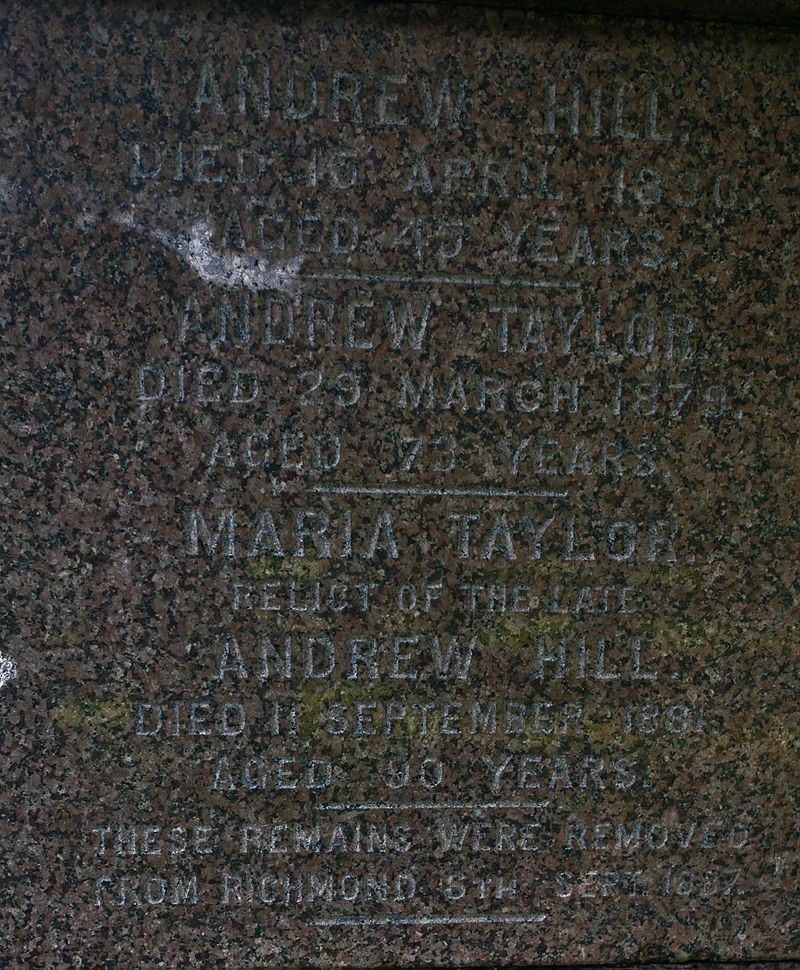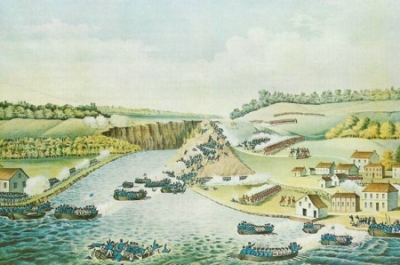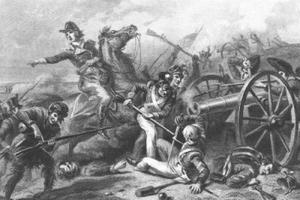A soldier all through - MARIA HILL
MARIA HILL Section 37, Plot 59 & 60
Throughout her long life of service to king and country, Maria Hill always thought of herself as “a soldier all through.” Even at age 90, she said her only regret was that she had “no sons to wear the British uniform and, if occasion called, offer his life for England.” She was what historians call “a daughter of the regiment,” raised from infancy in military traditions and lived as an army wife who followed the regiment into the war zones.
Born in Lancashire in 1791, Maria lost both her parents when she was still a child – a father who was an army surgeon in England and a mother who was remarried to a recruiting sergeant. Maria’s stepfather brought her to Upper Canada in 1799 and to Fort Amherstburg, near Windsor, where she married Sgt. Andrew Hill, an Irish soldier in the 100th Regiment of Foot in 1811. They had two daughters.
Fort Amherstburg was built by the Royal Canadian Volunteers at the mouth of the Detroit River to replace Fort Detroit, which Britain was required to cede to the United States of America in 1796 as a result of the Jay Treaty. Built in the years before the War of 1812, Fort Amherstburg included "King's Navy Yard" for shipbuilding on the upper Great Lakes (Lakes Erie, Huron, and Superior). The War of 1812 began and escalated quickly with US General William Hull invading Canada in July 1812. Soldiers from the fort repelled the Americans at River Canard. After General Hull retreated back to Fort Detroit, British General Isaac Brock and the Shawnee Chief Tecumseh met at Fort Amherstburg to plan the attack of Fort Detroit in the British Indian Department building located outside of the fort grounds. After losing the Battle of Lake Erie (including the flagship HMS Detroit, which was built at the nearby Navy Yard Park), the British/Canadians destroyed the fort and retreated as most of the cannons normally placed in the bastions were put onto the ships to be used for the engagement on Lake Erie and subsequently were lost.
She was one of the wives whom the army permitted to travel to the forts and armed camps where the women were given accommodations and food rations in return for caring for 600 men in the regiment. After the American invaders were defeated at the Battle of Queenston Heights on Oct. 13, 1812, Maria met Laura Secord who was searching the battlefield for her gravely-injured husband.
The Battle of Queenston Heights was fought during the War of 1812 on 13 October 1812. One of the most famous battles of the war, the Battle of Queenston Heights was the struggle for a portion of the Niagara escarpment overlooking Queenston, where more than 1,000 American soldiers crossed into Upper Canada. Part of the American force reached the top, circled the British artillery position and forced the British from the Heights. General Isaac Brock, one of the most respected British military leaders of his day, was killed leading a counter-attack. Mohawk chiefs John Norton and John Brant and about 80 Haudenosaunee and Delaware warriors held back the Americans for hours — long enough for reinforcements to arrive so that the British could retain the crucial outpost.
We know that Maria, a nurse, left Fort George and went to aid injured soldiers while “her husband [was] under arms among the rest” who were sent to fight the invading enemy. Playwright Sarah Anne Curzon, in her 1887 drama about Laura Secord, identified Maria as a “brave woman” who hid “her babe … under a wood pile” and walked among the wounded. She described Maria as “one in whom the heroic blood ran thick and strong as e’er in times gone by.”
When the U.S. army invaded again in 1813 and occupied the Niagara frontier, British generals ordered women and children to withdraw to Montreal. Legend says Maria disguised herself as a man, donning a redcoat, to follow Sgt. Hill. Her identity was revealed when she was run over by an ammunition wagon and examined by a doctor. She was partially disabled for life. Yet, as a nurse, she was allowed to stay and help the surgeons cope with overwhelming numbers of badly injured soldiers at the 1814 battles of Chippawa and the bloodiest, at Lundy’s Lane. Once the war ended, the Hills took land in the Richmond military settlement and ran the tavern in the town.
The Battle of Chippawa, on 5 July 1814, was an American victory over British forces in the War of 1812. The principal American campaign for 1814 centred on sending Major-General Jacob Brown's Left Division of the US Army into the Niagara Peninsula, where it would meet the American Lake Ontario squadron and then raid Burlington Bay, York or Kingston as circumstances allowed.
Maria died in 1881 and is buried in a family plot at Beechwood with two husbands and the only one of her children to survive – Margaret – who married Edward Malloch, an MP in early Upper Canada. A granddaughter, also named Maria, also shares the burial site.

She had become Lady Grant, having married Dr. James Alexander Grant, who was knighted by Queen Victoria for medical care of our first eight governors general. Dr. Grant was also a MP in John A. Macdonald’s government. They raised seven of their 12 children in a mansion on Elgin Street, which much later became Friday’s Roast Beef House.
The Grant House at 150 Elgin Street sits at the south east corner of the site at the intersection of Elgin Street and Gloucester Street. The two and a half storey brick structure — which was originally a residence — was constructed in 1875 for its first owners Dr. James Grant and Maria Grant. The design of the building is attributed to Bradish Billings (1783-1864) and the architecture is representative of the Second Empire style, which was made fashionable in France during the reign of Napoleon III (1852-1870). The House was designed by the City of Ottawa under the Ontario Heritage Act in 1982.



